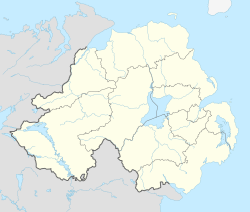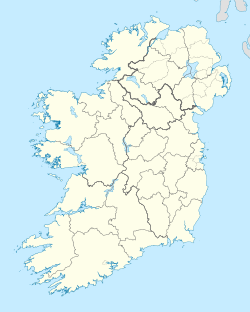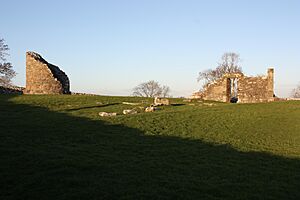Nendrum Monastery facts for kids
| Mainistir Naondroma | |
 |
|
| Monastery information | |
|---|---|
| Other names | Oendruim; Aonagh-urmuman; Oinach-urmuman; Nenddrum; Noindrum; Noendoma; Mahee Island |
| Order | Celtic monasticism Benedictine (from 1178) |
| Established | early 5th century? |
| Disestablished | between 974 and 1178 |
| Diocese | Down and Connor (Catholic) Down and Dromore (Church of Ireland) |
| People | |
| Founder(s) | Mochaoi:P |
| Architecture | |
| Status | Inactive |
| Site | |
| Location | Mahee Island, Strangford Lough, County Down |
| Coordinates | 54°29′53″N 5°38′53″W / 54.498°N 5.648°W |
| Visible remains | round tower, ruined church, cashel, tide mill |
| Public access | Yes |
Nendrum Monastery (which means Naondroim in Irish) was an old Christian monastery. It was built on Mahee Island in Strangford Lough, County Down, Northern Ireland. People believe it was started in the 5th century, but we are not completely sure.
The monastery stopped being active sometime between the years 974 and 1178. However, its church continued to be used by local people. The whole site was finally left empty in the 15th century. Today, you can still see some parts of this ancient monastery.
Contents
Exploring Nendrum's Past
Who Founded Nendrum Monastery?
People traditionally say that Mochaoi founded Nendrum Monastery in the 5th century. Mahee Island is even named after him! Mochaoi is a special kind of Irish name, like a nickname. His real name was Caolán. It is said that Saint Patrick himself appointed Mochaoi.
Ancient Technology: The Tide Mill
Scientists used a method called Dendrochronology to study a tide mill on the island. This method looks at tree rings to find out how old wood is. They found that the mill was built around the year 619. This makes it the oldest tide mill ever found by archaeologists anywhere in the world!
The monastery was like a small village. It had orchards for fruit, gardens for food, and fields for animals and crops. There was even a guest-house for visitors.
Important Dates and Events
Records from long ago, called annals, mention Nendrum Monastery many times. They talk about the death of St Mochaoi between 490 and 497. These records also suggest that Nendrum was an important place for a bishop. For example, St Cronan was called "bishop of Nendrum" around the year 640.
The last mention of Nendrum in these old records is in 974. The records say that "Sedna Ua Demain, Abbot of Nendrum, was consumed in his own house." This probably means he died in a fire, maybe during a Viking attack. Viking ships were often in Strangford Lough back then.
Rediscovering the Monastery
After 974, Nendrum seemed to disappear from history for a while. In 1178, John de Courcy gave the land to Benedictine monks from England. They built a small religious house there. By 1306, Nendrum was just a local church.
During the 15th century, the church was moved to a new village called Tullynakill. The old site of Nendrum was then forgotten. It was rediscovered in 1844 by William Reeves. He found the remains of a round tower and realized it was the lost monastery.
Archaeological Discoveries
What Archaeologists Found
Between 1922 and 1924, H. C. Lawlor led a big dig at Nendrum. The items found are now kept in the Ulster Museum. They found about 30 slate tablets with cool Celtic designs. These were like practice pieces for artists. A bell and a stone with ancient writing called runes were also found.
Other parts of the site were dug up later by different archaeologists. Lawlor's work was very important because it was one of the first big digs of a monastery. Even though modern archaeologists have new ways of digging, Nendrum is still special. It is one of the few ancient monastery sites with detailed reports about its discoveries.
Amazing Features of Nendrum
The Cashels and Central Area
Today, you can see three round stone walls, called cashels, at Nendrum. These walls were rebuilt in the 1920s. The middle cashel holds the remains of the round tower. It also has a ruined church with a sun-dial and an old graveyard. The second cashel has what might have been a "monastic school" or workshop.
The Ancient Sundial
At the ruined church, there is a special canonical sundial. It was put back together from pieces found in 1924. This sundial is thought to be from around the year 900. It is one of only a few early medieval sundials still known today. It looks like a tall stone pillar, about 190 cm high. The dial and its pointer, called a gnomon, are at the top.
The Nendrum Tide Mill
The Nendrum Monastery mill was a tide mill on the island. It used the power of the tides to grind grain. This mill is the oldest excavated tide mill, dating back to 787 AD. Its large millstones were 830mm wide. The mill's horizontal wheel could produce a good amount of power. Even older mill remains from 619 AD were also found here.
Nendrum Today: A Place of Reflection
Nendrum is part of a group of churches called the United Parish of Killinchy, Kilmood and Tullynakill. The local Rector, Rev. Dr. Stanley Gamble, looks after the spiritual side of this ancient site. Every year, on the Sunday after the summer solstice, the parish holds an outdoor church service inside the old church walls.
On June 25, 2017, a special event happened. The first Christening service since the monastery closed took place there! Another church, St. Mary's Parish, Comber, also holds an annual service at the monastery on Palm Sunday.
Visiting Nendrum Monastery
How to Get There
Mahee Island is located in Strangford Lough. This area is known for its amazing natural beauty. You can reach the island by driving on narrow roads and causeways. These lead off the A22 road, which goes south from Comber towards Downpatrick.
Visitor Information
A small cottage was built on the island in the early 1900s. It is now a visitor centre. You can visit the island every day from 10 am to 6 pm between Easter and September 30. From October to Easter, it is open on Sundays from 12 pm to 4 pm. It is a great place to learn about history and enjoy nature!
Gallery
See also
- Nendrum Monastery mill
- Abbeys and priories in Northern Ireland - County Down










